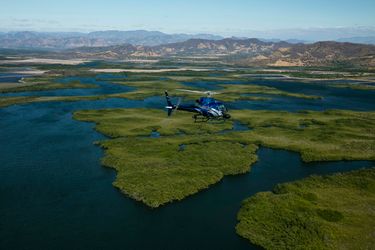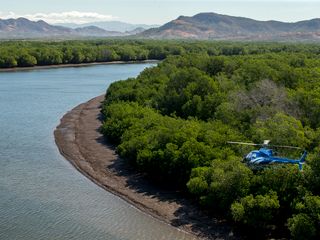Summary
- French Polynesia, Honduras, the Great North . . . this fall, audiences will be treated to scenes of exploration and discovery in ultra high-definition, through the Explorers Network documentary series. Taking a visual snapshot of our planet today, the show’s creators travel the world to capture Nature’s marvels on film - a feat made possible in part by specially - equipped H125 helicopters.

“As we travel through a country, we discover its heritage, animals, people, and culture. With each show, we mount a specific expedition to discover something new.”
For the past twenty years, Olivier Chiabodo, the presenter and force behind the Explorers Network series, has had a dream to film the Earth for posterity. A doctor early on, he wanted to do a check-up on the planet as he’d done for his patients. Its purpose would be to “see what’s happening at the level of culture, nature, environment—to show to the greatest number of people how beautiful it is, and that we must protect it.”
The show finally took off three years ago when Chiabodo discussed the project with a former TF1* colleague turned producer. Since then, he has been hard at work turning dream into reality.
A typical episode requires three or four months to prepare in the hands of a team of 24. Often, several shows are under preparation at the same time. To date, the team – employing variously a seaplane, helicopter, and off-road vehicles to film – has shot in the Arctic, French Polynesia, and most recently Honduras, capturing footage on the ice, underwater, and in dense virgin forests. The show maintains an editing studio on board a boat with a helipad, in use by the crew’s H125.
“We film everything at a very high level of quality,” said Chiabodo. “This means 4K or UHD**, because we want it to last. That implies working with high-level material and it’s why aerial shots are done with fairly large systems in which we can put big cameras. For this we use the H125. ”
Two helicopter pilots are employed, a man and a woman, to fly the H125s that the producers typically hire on location. A Sony F65 camera sits in the nose of the helicopter; its powerful lens lets the aircraft remain relatively distant from the action while zeroing in up to 1,000 mm on scenes of a sensitive nature. This has allowed the crew to capture footage of wild horses atop a cliff, and of a man spearfishing in solitude.
“There are a lot of inaccessible locations,” Chiabodo said. “Notably in a country like Honduras where some areas are difficult to access. There are mountains everywhere and there’s the virgin forest. The helicopter is an extraordinary machine that lets us reach places like that.”
In the cabin’s interior, Chiabodo’s chief operator sits in the rear passenger seat with a joystick. Watching the scene outside with the aid of a screen in front of him, he is able to direct the camera and zoom. A second helicopter carries crew who film The Explorers’ H125 as it hovers over serpentine rivers and snow-laden mountainsides.
In Honduras, working hand-in-hand with the Honduran military, the team mounted an expedition to find a city located deep in the tropical forest. Local pilots flew with the French crew to help navigate. “It was really a shared experience and one of teamwork with the Honduran army,” said Chiabodo. “And they discovered some of the benefits of Airbus Helicopters choppers. They really liked the H125’s performance and versatility.”
Around 70% of an episode is planned in advance, but the crew recognize the need to leave room for instinctive filming. “You must be flexible and pay attention,” said Chiabodo. “There are some incredible things which happen right in front of you. We need to stay concentrated and instantly seize on them.”
Audiences will be able to watch many of these up-close encounters soon on television, IMAX, cinema, and on the web, where short clips will offer a quick glimpse of the show’s progress around the globe.
For more, go to www.theexplorers.com
*TF1: French television station
** UHD: ultra-high definition




